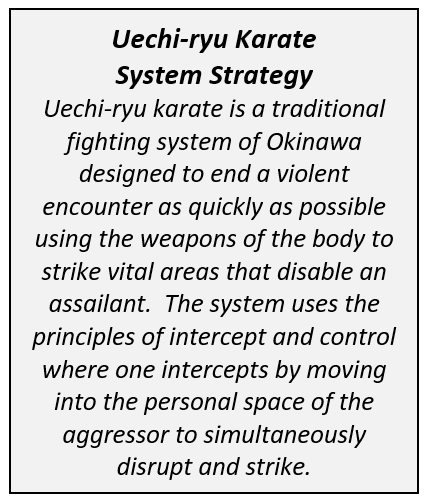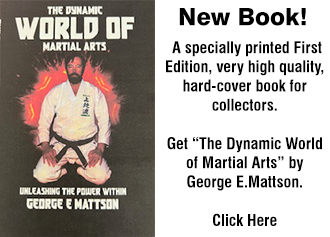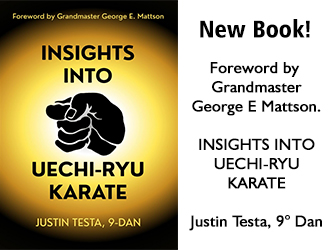by George E. Mattson and Justin Testa
Recently one of our members wrote to us to explain that he was involved in a threatening incident with another individual that raised the question, “Will all the training work?”. Fortunately, the situation did not escalate into a fight, but it did raise this all-important question, and more. As the situation escalated, he was fearful that his training for the past two years would not work. With all the repetitions of kata and techniques would he be able to defend himself? This led him to question how best to prepare himself should the situation arise again.
In this newsletter we discuss the overriding question “Will it work?”, and address some of the other questions and concerns that came into his mind because of this experience.
Before we address the question of “Will it work?”, let’s first address the more important question of “when to defend oneself?” The answer is, when you have no choice, and your life or that of a loved one, is on the line.
In his 2017 book “When Violence is the Answer”, self-protection expert Tim Larkin defines two categories of encounters that dictate whether action is called for: “anti-social aggression” and “asocial violence.” Larkin defines anti-social aggression as “quasi-violent scenarios that stem from conflict and jockeying within the social hierarchy. It is about communicating with lots of taunting and posturing…the intent is not to inflict grievous bodily harm; it’s only to exert social dominance.”
These confrontations may be brought on by a verbal insult, a disagreement at a bar, road rage, offensive gesture, etc. The risks, both legal and physical, are much too high to allow this type of encounter to become a physical altercation; such risks must be avoided by using social skills to de-escalate the situation or by walking away. Larkin goes on to define asocial violence as “violence that has nothing to do with communication or social hierarchy…there is no talking in asocial violence; it is about destruction…if you have not been able to foresee or escape it, you must incapacitate your attacker to survive.”
Question 1: “Will It Work?”
Whether you train in a virtual or physical dojo this question and concern are not unique, rather, thoughts that everyone has experienced. There is no simple answer to the question of “Will it work?”. The self-defense techniques of a traditional karate system such as Uechi-ryu are embedded in the kata. Kata was created to be practiced until the techniques within become muscle memory. Only if those “muscle memories,” your state of mind, and intent are ready to respond will you be able to protect yourself, but it is not a guarantee. In a self-defense situation, one never knows what will happen; there are no rules.
Question 2: Do I continue with Uechi-ryu training or study another martial art?
This incident raised the question of whether studying Uechi-ryu is the best way for our member to defend himself in the future. After thinking about the incident and researching his options, our member decided to continue to pursue his study of Uechi-ryu and to supplement his training by joining another martial arts school where the focus is on sparring.
But does sparring prepare you to defend yourself? No, sparring does not adequately prepare you, nor is it a prerequisite for being able to defend yourself. Regardless of how much you practice performing drills, bunkai, or sparring, it isn’t the same as an actual violent encounter where the attacker is trying to seriously hurt you. While sparring does provide the stressful experience of what it feels like to have someone trying to hit you, there are rules and general courtesies in the dojo and competitive sparring events that do not translate into a violent street situation.

For example, in the early days of competitive sparring, and even today, when sparring at the dojo, one was trained to “pull your punch” so that you would not get penalized for hitting someone in the face. This is not the right muscle memory to develop if self-defense is your goal. In the street, you are also unlikely to be facing someone who is trained to attack and defend in the same ways that you learn in the sparring ring.
Real world situations are completely unpredictable and violent predators are experts in delivering serious injury. Even in Mixed Martial Arts there are many illegal techniques that are not “illegal” in the street, such as attacks to the groin, head butts, stomp kicks, eye gouging, hair pulling, biting, and the use of weapons (clubs, knives, guns, rocks, etc).
Without minimizing the benefits of sparring, one needs to understand that real violence is very different and will not look like a sparring match.
Question 3: Why is there a different emphasis on technique between Uechi-ryu and sparring?
After starting a new martial arts program emphasizing sparring, our member observed that sparring training methods emphasize techniques that are different from those in Uechi-ryu karate training. The main difference in Uechi-ryu karate is that the system is designed for self-defense, so many of the principles and techniques don’t apply to sparring because they are not allowed.
Our member observed that in his sparring training program there is less emphasis on performing techniques with precision, whereas in Uechi-ryu training we put a lot of emphasis on the accuracy of the techniques. As a martial artist faced with a self-defense situation, the perfection of the technique is the least of your concerns. However, the importance of practicing accurate techniques is to be able to deliver effectively targeted strikes under the stress of a violent encounter.
Question 4: Isn’t hard sanchin training better for preparing your body for self-defense than the body flow and kime (focus of power) principles of the Old Way?
For many years we performed our Sanchin kata with dynamic tension emphasizing the hard of the half-hard/half-soft principle of Uechi-ryu. Although performing Sanchin with dynamic tension can be a very good resistance training exercise and makes for good demonstrations, it makes it difficult to develop the muscle memory required to relax and tense at the right times. Sensei Mattson’s “Old Way” approach is a path to achieve the half-hard/half-soft principles of Uechi-ryu using body flow and kime. The shift from a no-tension body flow state to kime and then back to a no tension state happens very fast. Professional boxers and MMA fighters train to develop a punching style with a relaxed flow for speed and a quick focus of power on impact.
Many of us began our martial arts journey driven by the desire to learn how to defend ourselves. It is impossible to predict how one will react in a stressful self-defense situation because there are so many variables involved. Our mind, karate skills, and physical condition are all factors that contribute to one’s ability to handle a stressful self-defense situation. Through the study of kata we develop these skills, but it takes practice, repetition and time. You must build these muscle memory tools of self-defense while memorizing your own, “I’m ready” message, which you must repeat thousands of times while training and be ready to say it when necessary to protect yourself and family.
We bear the responsibility in learning Uechi-ryu karate to avoid using our fighting skills unless there is absolutely no other choice. We are using our Uechi-ryu karate when we choose to not provoke, to de-escalate, and to walk away.





